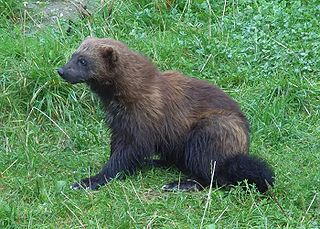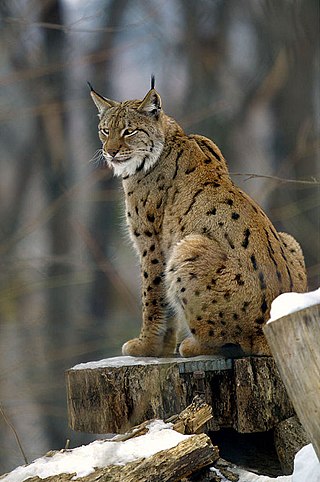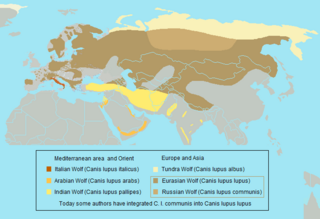Related Research Articles

The wolf, also known as the gray wolf or grey wolf, is a large canine native to Eurasia and North America. More than thirty subspecies of Canis lupus have been recognized, including the dog and dingo, though gray wolves, as popularly understood, only comprise naturally-occurring wild subspecies. The wolf is the largest extant member of the family Canidae, and is further distinguished from other Canis species by its less pointed ears and muzzle, as well as a shorter torso and a longer tail. The wolf is nonetheless related closely enough to smaller Canis species, such as the coyote and the golden jackal, to produce fertile hybrids with them. The wolf's fur is usually mottled white, brown, gray, and black, although subspecies in the arctic region may be nearly all white.

The wolverine, also referred to as the glutton, carcajou, or quickhatch, is the largest land-dwelling species of the family Mustelidae. It is a muscular carnivore and a solitary animal. The wolverine has a reputation for ferocity and strength out of proportion to its size, with the documented ability to kill prey many times larger than itself.

The Eurasian lynx is one of the four extant species within the medium-sized wild cat genus Lynx. It is widely distributed from Northern, Central and Eastern Europe to Central Asia and Siberia, the Tibetan Plateau and the Himalayas. It inhabits temperate and boreal forests up to an elevation of 5,500 m (18,000 ft). Despite its wide distribution, it is threatened by habitat loss and fragmentation, poaching and depletion of prey.

An apex predator, also known as a top predator, is a predator at the top of a food chain, without natural predators of its own.

The Eurasian wolf, also known as the common wolf, is a subspecies of grey wolf native to Europe and Asia. It was once widespread throughout Eurasia prior to the Middle Ages. Aside from an extensive paleontological record, Indo-European languages typically have several words for "wolf", thus attesting to the animal's abundance and cultural significance. It was held in high regard in Baltic, Celtic, Slavic, Turkic, ancient Greek, Roman, Dacian, and Thracian cultures, whilst having an ambivalent reputation in early Germanic cultures.

The Italian wolf, also known as the Apennine wolf, is a subspecies of the grey wolf native to the Italian Peninsula. It inhabits the Apennine Mountains and the Western Alps, though it is undergoing expansion towards the north and east. As of 2022 the wolf population within Italy is estimated to be 3,307 individuals. Although not universally recognised as a distinct subspecies, it nonetheless possesses a unique mtDNA haplotype and a distinct skull morphology.
The Macedonian Ecological Society (MES) was founded in 1972, in what was then known as the Socialist Republic of Macedonia.

Duck Mountain Provincial Park is a 1,424 square kilometre provincial park in western Manitoba. The park is located within the larger and similarly named Duck Mountain Provincial Forest. Duck Mountain Provincial Park was designated a provincial park by the Government of Manitoba in 1961. and is considered to be a Class II protected area under the IUCN protected area management categories. The park is unincorporated, not lying within the borders of any of Manitoba's rural municipalities.

Pleistocene rewilding is the advocacy of the reintroduction of extant Pleistocene megafauna, or the close ecological equivalents of extinct megafauna. It is an extension of the conservation practice of rewilding, which aims to restore functioning, self-sustaining ecosystems through practices that may include species reintroductions.

Wolf attacks are injuries to humans or their property by any subspecies of wolf. Their frequency varies with geographical location and historical period, but overall gray wolf attacks are rare. Wolves today tend to live mostly far from people or have developed the tendency and ability to avoid them. The country with the most extensive historical records is France, where nearly 7,600 fatal attacks were documented from 1200 to 1920. There are few historical records or modern cases of wolf attacks in North America. In the half-century up to 2002, there were eight fatal attacks in Europe and Russia, three in North America, and more than 200 in south Asia. Experts categorize wolf attacks into various types, including rabies-infected, predatory, agonistic, and defensive.

The Balkan lynx is a subspecies of the Eurasian lynx in the genus Lynx. It is found in Albania, Kosovo and western North Macedonia, with smaller populations in Montenegro. It is considered a national symbol in North Macedonia and appears on the 5-denar coin.

The Caucasian lynx, also known as the Caucasus lynx or the eastern lynx, is a subspecies of Eurasian lynx native in the Caucasus, Iran, Turkey, and European Russia.

The northern lynx is a medium-sized subspecies of the Eurasian lynx.

Montenegro is the smallest Balkan nation in population and second smallest in land mass. The land mass is 13,812 square kilometres with 360 square kilometres of water. Montenegro's geography ranges from mountainous forested regions in the north where larger mammals are most common. Mediterranean coastline makes up the south end of the country, forested area makes up 40.4% of the nation's landmass. The most densely populated area of the country is the south coast and the most sparsely populated is the north east section of the country. The fauna of Montenegro is predominantly shared with surrounding Balkan nations.
Luigi Boitani is a professor of zoology at the Sapienza University of Rome, whose research interests include ecology, the protection of large mammals, and the management of protected areas. Boitani is president of the Large Carnivore Initiative for Europe.
Ilka Reinhardt is a German biologist and wolf expert. She is together with Gesa Kluth Founder and director of LUPUS - Institute for Wolf Monitoring and Research in Germany and the Freundeskreis freilebender Wölfe. She was appointed by the Saxon State Ministry for the Environment and Agriculture as the wolf commissioner. Ilka Reinhardt works with the International Fund for Animal Welfare (IFAW) and Naturschutzbund Deutschland. In Poland, the biologist Sabina Nowak has a similar position. Ilka Reinhardt and Sabina Nowak are members of the Large Carnivore Initiative for Europe and cooperate with the CEWolf Consortium.
Sabina Nowak is a Polish scientist and wolf expert. She is president of the Association for Nature Wolf and a member of the Large Carnivore Initiative for Europe.

The favourable conservation status of wolves is the definition of a wolf population that is no longer threatened with extinction, that is capable of long-term survival. In Europe the favourable conservation status is defined by the Guidelines for Population Level Management Plans for Large Carnivores. It is the minimum viable population, that can be of different numbers of wolves depending on their connectivity with neighbouring populations. According to the IUCN guidelines, at least 1000 adult animals are required for isolated populations. If a wolf population is effectively linked genetically and demographically with other wolf populations, more than 250 mature wolves may be sufficient.
References
- ↑ IUCN - SSC Groups: Large Carnivore Initiative for Europe Archived 2020-10-23 at the Wayback Machine
- ↑ Large Carnivore Initiative for Europe: Who we are
- ↑ LCIE: Vision
- ↑ Hillstrom, Kevin; Hillstrom, Laurie Collier (2003). Europe: A Continental Overview of Environmental Issues. Santa Barbara, Calif.: ABC-CLIO. p. 42. ISBN 1-57607-687-3. OCLC 53015854.
- 1 2 Zouwen, van der, Mariëlle (2006). Nature Policy Between Trends and Traditions: Dynamics in Nature Policy Arrangements in the Yorkshire Dales, Doñana, and the Veluwe. Delft: Eburon. pp. 122 f. ISBN 978-90-5972-097-8. OCLC 70122824.
- ↑ Rodríguez, Alejandro; Calzada, Javier (2014-04-15). "IUCN Red List of Threatened Species: Lynx pardinus". IUCN Red List of Threatened Species. Retrieved 2020-12-12.
- ↑ Large Carnivore Initiative for Europe
- ↑ Status of large carnivore populations in Europe 2012-2016
- ↑ European Commission: Environment Library
- ↑ Standing Committee: List of decisions and adopted texts Seite 5, 7, 19
- ↑ ResearchGate: Status, Management and Distribution of Large Carnivores – Bear, Lynx, Wolf and Wolverine in Europe. Part 1
- ↑
- J. Linnell, V. Salvatori, L. Boitani: Guidelines for Population Level Management Plans for Large Carnivores. LCIE 2008
- ↑ Unautorisierte Übersetzung: Leitlinien für Managementpläne auf Populationsniveau für Großraubtiere Archived 2020-10-16 at the Wayback Machine
- ↑ Kristina Vogt, Urs Breitenmoser et al.: 25 Jahre Wolf in der Schweiz – Eine Zwischenbilanz Archived 2020-10-23 at the Wayback Machine KORA Bericht Nr. 91
- ↑ Ilka Reinhardt, Petra Kaczensky et al.: Management of bold wolves - Policy support Statement of the Large Carnivore Initiative for Europe
- ↑ Urs Breitenmoser, John Linnell et al.: Leitlinien für das Monitoring von Luchsen Archived 2020-10-27 at the Wayback Machine
- ↑ Luise Kruckenhauser, Georg Rauer et al.: Genetic monitoring of a founder population of brown bears (Ursus arctos) in central Austria
- ↑ Göran Ericsson, Jonas Kindberg, Göran Bostedt: Willingness to pay WTP for wolverine Gulo gulo conservation
- ↑ Odmung Kleven, Jonas Kindberg et al.: Estimation of gene flow into the Scandinavian wolverine population
- ↑ Bundesamt für Naturschutz: Pilotstudie zur Abwanderung und zur Ausbreitung von Wölfen in Deutschland
- ↑ European Commission: Life and human coexistence with large carnivores
- ↑ Rewilding Europe: United for the conservation of Europe’s large carnivores